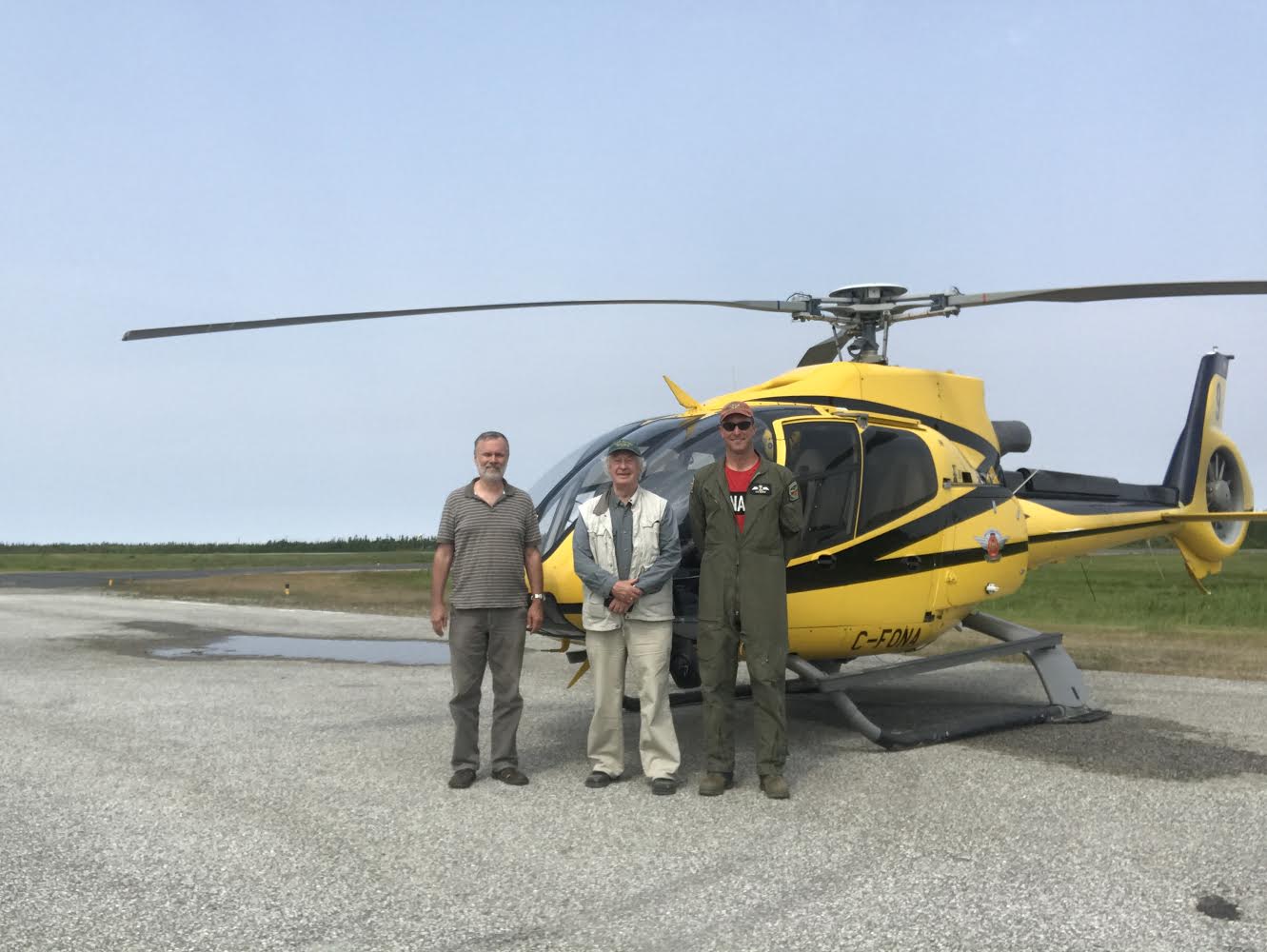Aerial Survey 2018
Christian Friis and Guy Morrison
Aerial survey crew. (l-r): Ken Ross, Guy Morrison, Rob Burns. Photo courtesy Rob Burns.
Between 10 and 12 August 2018, Guy Morrison (Environment and Climate Change Canada, Emeritus Research Scientist) and Ken Ross (retired ECCC Canadian Wildlife Service biologist), along with Ontario Ministry of Natural Resources and Forestry (OMNRF) pilot Rob Burns, conducted an aerial survey of the James Bay coast from the Quebec border in the east to Ekwan Point to the northwest, including Akimiski Island. The objective of the survey was to count shorebird species within smaller sectors generally delineated by tributaries or other landforms, allowing comparison with results from previous aerial surveys of the region. Small shorebird species (e.g., Least, Semipalmated, and White-rumped sandpipers) are generally not easily identified from the air, despite flying at low levels. These are grouped into “peeps”. Medium and large shorebird species (e.g., Black-bellied Plover, Red Knot, and Hudsonian Godwit) are generally identifiable from the air; Greater and Lesser yellowlegs are generally counted as yellowlegs species. Surveys are conducted by helicopter at high tide, when birds are concentrated into roost locations. At low tide, birds are spread out across kilometres of exposed sand and mud flats that are characteristic of the James Bay coast. The low profile of the coast generates vast expanses of exposed flats at low tide, making it virtually impossible to get a reliable count at this point in the tidal cycle. In addition to counting shorebirds, we had a VHF receiver hooked up to an antenna at the nose of the helicopter logging locations of nanotagged birds detected along the coast. Personnel stationed at the three field camps located at Northbluff Point, Little Piskwamish Point, and Longridge Point carried out a coordinated ground count. Ground counts can be used to estimate species composition of the aerial counts.
The crew met in Timmins on 10 August 2018, flew to Moosonee in the OMNRF helicopter, and began the survey based on the predicted high tide in the early afternoon. Beginning at the Moose River, the crew flew northwards along the coastline towards Ekwan Point. Between Northbluff and Piskwamish, they recorded over 5,000 Red Knot, among a total of some 12,500 individual shorebirds. The next significant concentration of shorebirds was recorded at Chickney Channel, which is north of the Albany River. The crew recorded over 90,000 shorebirds including 11,500 Hudsonian Godwits and over 78,000 peeps! The survey concluded for the day at Ekwan Point and the crew spent the night at the White Wolf Lodge in Attawapiskat.
The next day, the crew surveyed Akimiski Island in the morning. On the northwest side of the island, over 8,000 Red Knot were recorded! This is a new location for knots based on previous aerial work dating back to the 1970s. In this section of Akimiski, nearly 60,000 individual shorebirds were recorded, including close to 49,000 peeps. The southwestern section of the island had over 29,000 individuals, including over 1,600 Marbled Godwit. Akimiski harboured 98% of the Marbled Godwits recorded on the survey.
From Akimiski, the crew flew south to complete the survey from the Moose River east to the Quebec border. The greatest concentration of birds was in the Hannah Bay Migratory Bird Sanctuary, where over 26,000 individual shorebirds were recorded, including over 1,000 Hudsonian Godwits.
Snow Geese in flight near Chickney Channel.
Shorebirds in flight. Photo courtesy Karl Bardon.
Over 240,000 individual shorebirds were recorded during the survey, easily doubling the totals from 2016 (about 110,000) and 2017 (about 105,600). The 2018 count for small shorebirds totaled over 206,000, which is significantly higher than the 2017 (92,500) and 2016 (77,000) counts. The count for medium shorebirds (over 19,000) was higher in 2018 than in 2017. The count for large shorebirds (over 18,000) was higher in 2018 than in either 2016 or 2017. In 2017, 7,200 medium and 5,900 large shorebirds were counted, while in 2016, 20,400 medium and 11,800 large shorebirds were counted. The Red Knot count of over 13,000 was the highest of the 3 surveys in 2016, 2017 and 2018, although the birds were distributed differently, with a moderate (though still significant) number in the southern part of the bay from approximately Longridge to Northbluff (about 5,000 compared to a maximum of 10,000 in 2016) and a new and very significant concentration of some 8,000 on the northwest coast of Akimiski Island.
Reasons for the significantly higher number of birds in 2018 are currently unclear but are likely connected to the widely reported very poor breeding conditions in the Arctic in 2018 (https://www.audubon.org/news/shorebirds-experience-dismal-breeding-season-due-quirk-climate-change). Late snow melt resulting in high snow cover early in the season may have significantly delayed breeding attempts for many species, with a subsequent delay in the southward migration. For instance. initial reports from Yves Aubry’s (ECCC biologist) studies on the Mingan Island Archipelago on the north shore of the St. Lawrence River suggest that migration of Red Knots was around 10-14 days later than normal. If similar considerations apply to other shorebird species, the large numbers observed in James Bay in 2018 may reflect a later migration, since by the August survey dates in 2018 (consistent over the three years) many birds would have already passed through the area in a more “normal” (previous) year. Alternatively, perhaps the birds were in poorer condition after the difficult summer in the Arctic and needed to stay longer in James Bay to build up stores for migration. Interestingly, in previous years where aerial surveys have been conducted in James Bay (1976 to 2009), the only year with a total autumn count over 200,000 individuals (292,000) was in 2001, which was noted as a seasonably late and relatively poor breeding year in the Arctic (see http://www.arcticbirds.net/). Further analysis of ground counts from James Bay in 2018 should indicate whether the difficult/delayed breeding conditions in the Arctic in 2018 resulted in poor breeding success for many species.


